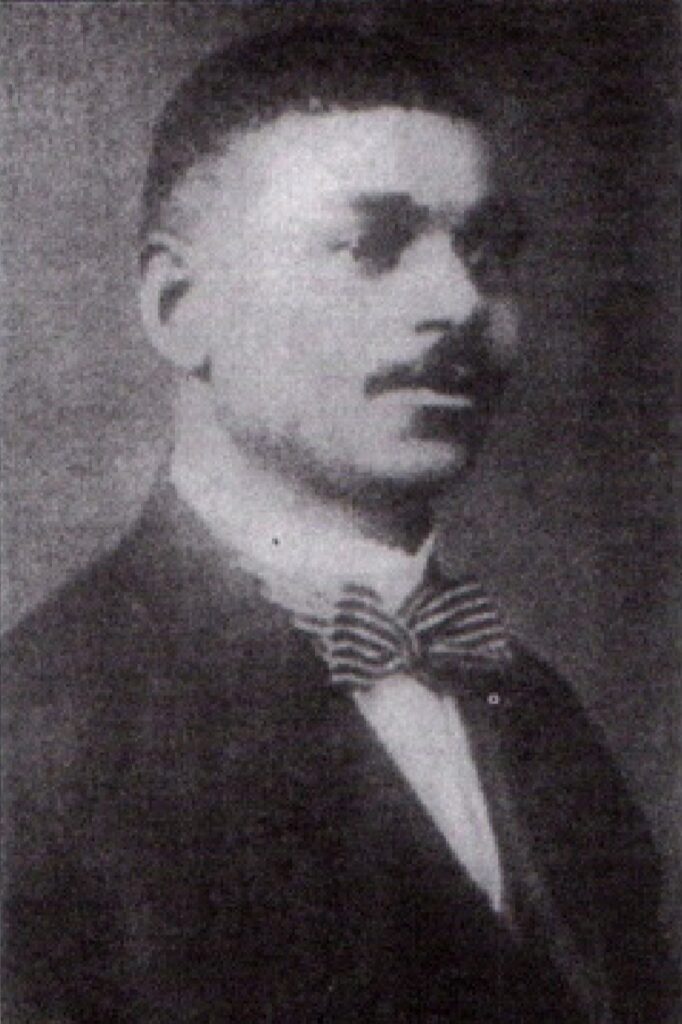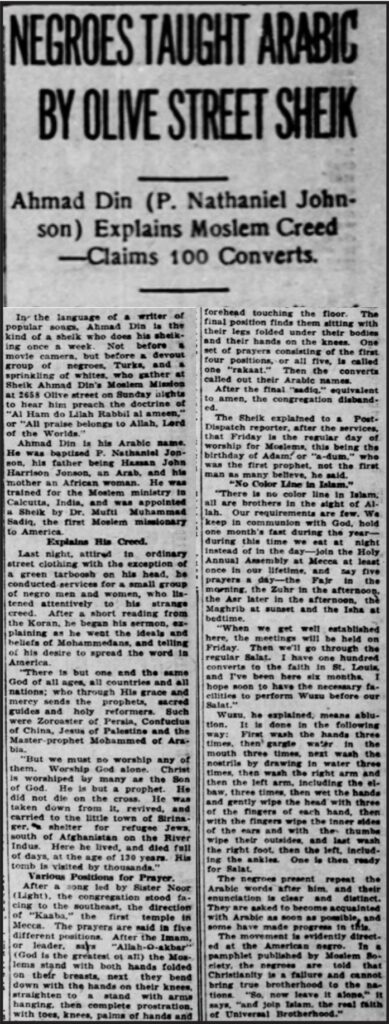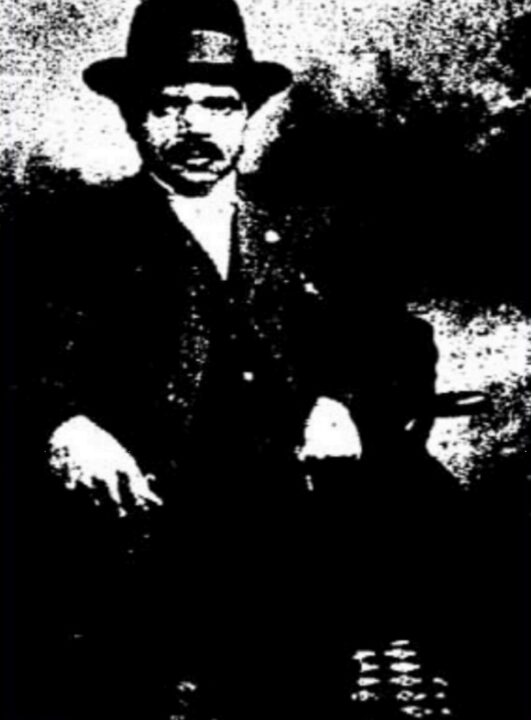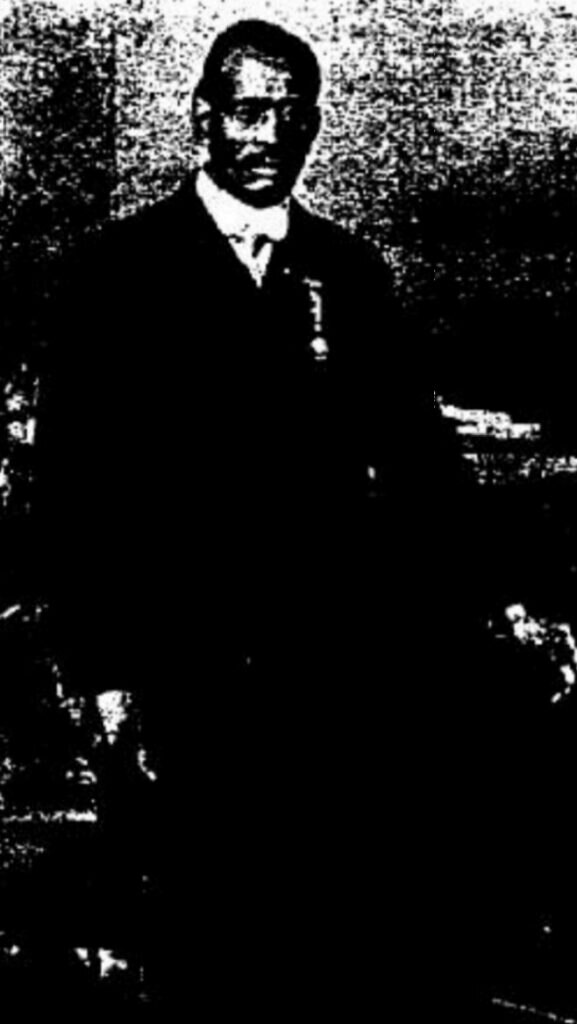This series of articles focuses on the African-Americans who Hazrat Mufti Muhammad Sadiqra brought under the banner of the true Islam during his time in America between 1920 and 1923. The converts all came from varying backgrounds. Ultimately, they became zealous preachers of Islam Ahmadiyyat in America.
Dr Talha Sami, UK
Sheikh Ahmad Din – The first African-American Ahmadi missionary
“There is no color line in Islam; we all are brothers in the sight of Allah. Our requirements are few. We keep in communion with God, hold one month’s fast during the year – during this time we eat at night instead of in the day – join the Holy Annual Assembly at Mecca at least once in our lifetime, and say five prayers a day – the Fajr in the morning, the Zuhr in the afternoon, the Asr later in the afternoon, the Maghrib at sunset and the Isha at bedtime. When we get well established here, the meetings will be held on Friday, then we’ll go through the regular Salat” (Sheikh Ahmad Din, “Negroes Taught Arabic by Olive Street Sheikh”, The Post Dispatch, 16 July 1923, p. 21)

P Nathaniel Johnson was a stalwart and early pioneer of the Ahmadiyya Muslim Community in the USA. He was born in Hempstead County, Arkansas on 10 June 1888 (other reports have mentioned 29 May). Johnson attended and graduated from Philander-Smith College in Little Rock, Arkansas. It has been suggested that he was from African or Arab ancestry and converted to the Ahmadiyya Muslim Community taking the name, Ahmad Din. He has been characterised in history as a religious seeker who experimented with many religions before coming to Islam (The Columbia Sourcebook of Muslims in the United States, pp. 54-58).
Ahmad Din’s conversion to Islam Ahmadiyyat was most likely between April 1922 and July 1922. (Correspondence & Assorted Files, DW, January 2012, Milwaukee)
Hazrat Mufti Muhammad Sadiqra writes that Ahmad Din “had been busy in bringing others to the fold of Islam”. (The Moslem Sunrise, Issue 2-3, 1923, p. 190)
Ahmad Din is accepted as the first African-American “sheikh” and was the first African-American missionary. In 1922, a picture of him appeared in The Moslem Sunrise declaring Ahmad Din as a newly appointed missionary.
Implementing Mufti Sadiq’s manner of propagation
Sheikh Ahmed Din took on the mantle of Mufti Muhammad Sadiq Sahibra by implementing many of the same techniques for tabligh (propagation of Islam) that Mufti Sahibra had advised and used himself.
Firstly, he worked hard to dismantle Christian doctrine that was rife in America.
Sheikh Ahmad told the St Louis Dispatch, “We must worship God alone. Christ is worshipped by many as the Son of God. He is but a prophet. He did not die on the cross. He was taken down from it, revived and carried to Srinagar.” (The Post Dispatch, “Negroes Taught Arabic By Olive Street Sheikh”, 16 July 1923, p. 21)
Secondly, Sheikh Din was able to attract a multi-racial congregation. Naturally, as an African-American, he attracted African-Americans to the fold of Islam Ahmadiyyat. Brother Hakim is a case and point of this. Sheikh Din left a chapter consisting of African-Americans and whites in St Louis, Missouri. (The Ahmadiyya Gazette, “Ahmadiyya Movement In Islam”, April 1977, pp. 47-48)
In 1922 he led a group of Muslims that included African-Americans, Turks and even Caucasians. Newspapers had reported on the followings Sheikh Din had established and said that he had a multiracial group of “negroes”, “Turks” and “sprinkling of whites” at his 2658 Olive Street mission. Sheikh Din famously said, “Islam has no colour line”. (The Moslem Sunrise, April & July 1922, p. 270).
The St Louis Post Dispatch reported in an article called “Negroes Taught Arabic by Olive Street Sheikh” published on 16 July 1923, that Sheikh Din had acquired 100 converts in the first six months of the mission in St Louis. The newspaper also reported:

“In the language of a writer of popular songs, Ahmad Din is the kind of Sheik [sic] who does his sheiking [sic] once a week. Not before a movie camera, but before a devout group of Negroes, Turks and a sprinkling of whites, who gather at Sheik Ahmad Din’s Moslem Mission at 2658 Olive Street on Sunday nights to hear him preach the doctrine of ‘Alhamdolilah rabbilal amen’ [sic] or ‘All praise belongs to Allah, Lord of the Worlds’ …
“I cannot claim to have done any great work, but I do hope by the grace of God that in clearing the way for future missionaries of Islam, I have done some pioneer work in sowing the seed of truth throughout the land which will grow up in time and going to big, tall, strong trees to feed and shelter thousand and send out healthy vibrations to millions.”
The third manner of tabligh was the way he engaged with his audience; he pursued intellectual discourse. Sheikh Din would personally tutor students himself and would formalise the process by handing out pledge forms. (Black Pilgrimage to Islam, pp. 93-94)
Sheikh Din was also concerned about the future. He had converted 100 people in six months. The meetings were on Sundays, but he said he aimed to bring them in line to Fridays as per Islamic customs. He also said he wanted to create proper wuzu [ablution] facilities for people before Salat. Sheikh Din incorporated women into participating in preaching.
At one prayer function, Sister Noor was said to have led a song; possibly a Quranic recitation. He also facilitated marriage (Black Pilgrimage to Islam, p. 93-94), presumably by conducting nikah ceremonies.
A sixth point is that he did indeed have an ecumenical approach. He told the St Louis Dispatch that Zoroaster, Confucius, Jesus and Muhammad were all prophets in line with Ahmadi teachings. His affection for Islam was apparent, as he stated “… the Holy Quran is the healthiest plant with the hardest stalk, produces the sweetest bloom and yields the most wholesome fruit”.
He also took on the mantle of comparative religions – later in the same article, he says that after studying the Vedas, it was “found to be a plant faded, green stands and a few green leaves from tree vines”. He made similar remarks about the Torah. (The Moslem Sunrise, “Living Flora and Dead”, 1924, p. 14)
The final point is that Sheikh Din instituted the second pillar of Islam with zeal in his teachings. An entire article in the St Louis Dispatch explains the complete wuzu process and positions of prayer, with Islamic terminology. Sheikh Ahmad Din converted 200 people to Islam and had a small entourage he would follow and preach with them. One member later became known as Brother Hakim (Black Pilgrimage to Islam, p. 93).
Sheikh Din’s residence became the mosque. His congregation would bring their own prayer rugs and he would teach them Islamic fundamentals which included the prayer, the manner of ablution and various prayers. It has also been noted that segregation between men and women was occurring with a curtain. (Black Pilgrimage to Islam, pp. 93-94)
Brother Omar
Another sheikh was Brother Omar who owned a lamasery shop where he sold religious garments, prayer rugs, roots, herbs, incense etc. (Black Pilgrimage to Islam, pp. 93-94).

It is interesting to note that decades later, the Nation of Islam became renowned for businesses, bakeries and land ownership. This was a trend amongst Muslims in America, started initially by Ahmadi missionaries such as Brother Omar and later missionary Dr Yusef Khan who would sell Islamic merchandise. Brother Omar took on the mantle of the Mufti; he said “the Bible is not for the Negro because it does not belong to him.” (Black Pilgrimage to Islam, p. 280)
Brother Hakim
“He possesses great spiritual powers and is a magnetic healer of extraordinary ability. He has been successful in converting many to Islam in Ahmadia Movement, and let us pray that he may long continue in the good work, and more fully develop the powers with which Allah has blessed him. He says that he has now been elevated to that plane of spiritual knowledge which Christianity was intended to lift him, but failed. There are many who say that they have been benefited by him both spiritually and physically.” (Hazrat Mufti Muhammad Sadiqra)

JH Humphries was originally from Ladysmith, Congo. He converted between April 1922 and July 1922. Humphries was a devout Christian and was actively involved in preaching it. He later migrated to the United States and at the age of 17, entered the Tuskegee Institute to study in a Christian ministry for five years. Humphries then met Sheikh Ahmad Din of St Louis who introduced him to Hazrat Mufti Muhammad Sadiqra. After listening to a convincing lecture on Islam by Mufti Sadiqra, Humphries was completely disillusioned by Christianity and accepted Islam Ahmadiyyat. He then adopted the name Hakim. (The Ahmadiyya Gazette, “Ahmadiyya Movement In Islam”, April 1997, p. 48)
After accepting Islam, Brother Omar re-directed his missionary efforts toward spreading Islam. (The Moslem Sunrise, Issue 2-3, 1923, p. 190)
Sheikh Abdus Salam
Sheikh Abdus Salam was originally Reverend BD Sutton. He converted between October 1922 and January 1923. Hazrat Mufti Sadiqra delivered five lectures in Detroit at the Universal Negro Improvement Association (UNIA) meetings; out of the 40 converts, one of them, Mufti Sahib said, was an enthusiastic young man with the name Rev Sutton. After his conversion, he took the Muslim name, Sheikh Abdus Salam and was appointed the leader of that congregation. (The Moslem Sunrise, Issue I, 1923, p. 167)
Mufti Sadiq Sahibra cites Sheikh Abdus Salam and Sheikh Ahmad Din as prolific proselytisers (The Moslem Sunrise, Issue 2-3, 1923, p. 190).
Sheikh Salam went on to become one of the principal preachers in Detroit. He was described as “busy bringing others to the fold of Islam”. (The Moslem Sunrise, Issue 2-3, 1923, p. 190).
Sheikh Ashiq Ahmad
Sheikh Ashiq Ahmad was another convert ordained by the Mufti and possessed better knowledge of Arabic in the Holy Quran than others. Sheikh Ashiq Ahmad travelled between Cincinnati and Dayton tending to several thousand contacts. He helped formulate an itinerary that aimed to spread Islam in America and also wrote letters and flyers that were sent from St Louis, Cincinnati, Dayton, Columbus, Accrington and Cleveland. Sheikh Ashiq also turned towards the Garveyites [supporters of Marcus Garvey] to preach; Mufti Sadiqra had fostered amicable relations with Garvey’s Universal Negro Improvement Association (UNIA), so much so that the latter would even rent meeting halls to Ahmadi Muslim missionaries for a nominal fee. Both organisations were working towards a similar goal of racial equality. (Black Pilgrimage to Islam, p. 96)
Sheikh Muhammad Ibrahim
AES Mondezie was born in Princetown, Trinidad and later migrated to the United States. He came into contact with the Ahmadiyya movement and joined Islam in January 1923. He studied Islam for two years, most of which was likely under Mufti Sadiq Sahibra. It was Maulvi Muhammad Din who wrote of him when he was appointed as a Muslim missionary at Princes Town, Trinidad. He took the Muslim name Muhammad Ibrahim. There were around 15,000 scattered Muslims over the island, which he was working to bring together. Din wrote that he was successful in converting several individuals to the movement. Sheikh Ibrahim also continued to use the ecumenical approach to bring together Muslim delegates from the island for cooperation. (The Moslem Sunrise, Issue 4, 1923, p. 270) (Mahmood Kauser, Early Ahmadi Converts of North America, Jamia thesis, pp. 81-82)
Conclusion
“Rev Bd D Sutton (Sheik Abdus Salaam) of Detroit; Sheikh Ahmad Din of St Louis, MO; Brother Yousaf (Mr Joseph) Sister Saeeda in Gary, Ind and Sister Amina (Mrs Anne Brooks) of Chicago Heights have been busy in their places convincing the people of the truth of Islam and have been successful in converting many to the blessed fold.” (Mufti Muhammad Sadiq Sahibra, The Moslem Sunrise, Issue I, 1923, p. 167)
Mufti Muhammad Sadiq Sahibra left no stone unturned or no avenue unchecked in terms of spreading Islam in America; he appealed to the common man and also the academic. He empowered those who he came into contact with him and helped them preach Islam themselves. To him, race and gender were not discriminatory factors in Islam. These “Sheikhs” became active and zealous preachers of Islam under the Mufti’s tenure and beyond.
(The next article will focus on the pious Muslim women who converted during the tenure of Hazrat Mufti Sadiqra but also went on to be zealous preachers of Islam Ahmadiyyat)

